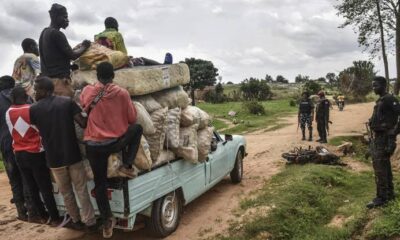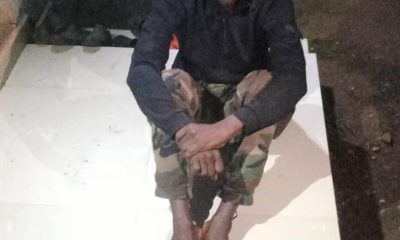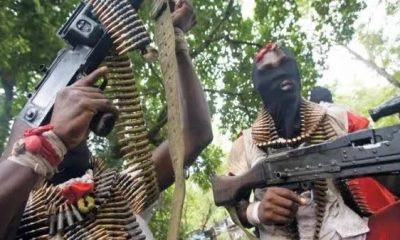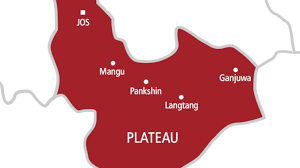News
19 year old man shot on the Plateau

19 year old man shot on the Plateau
By: Bodunrin Kayode
A 19 year-old, Jude Nicodemus is feared killed by bandits who invaded Gana Ropp village on Wednesday.
Two other young people were severely injured by the bandits in the same village in Barkin Ladi council Area of Plateau State.
The incident according to Rwang Tengwong the National Publicity Secretary of the Berom youth movement (BYM) happened on Wednesday night, at around 8:00pm in the night.
In a release the publicity secretary noted that: “This is one among recent renewed attacks and killings without any form of provocation in Barkin Ladi, Riyom, Bokkos and Mangu by the marauders, who have vowed to make the forthcoming Christmas and New year come with mixed feelings in the State.”
He observed that the tragic incident among others occurred, following intelligence reports, which revealed that the invading groups have vowed to resumed hostilities in villages and Communities during the Christmas celebrations.
” The Berom Youth Moulders-Association, BYM under the leadership of Solomon Dalyop Mwantiri, Esq. is unreservedly condemning the recent killings in some parts of Plateau State, and in the same vein, calling on all security outfits, particularly the Operation Safe Haven-OPSH under the able and patriotic command of Maj. Gen. A. E Abdulsallam, who doubles as the GOC 3rd Armoured Division to redouble up efforts in combating resurgence of acts of terrorism, and flushing out the terrorist elements that are said to have been stationed in the hills of Were in Ropp of Barkin Ladi LGA and some parts of Plateau.” the release noted.
Meanwhile, the BYM has commended the rapid response of Sector 4 Commander, Col. US Abdulsallam, for his swift action that forestalled further casualties in the general area.
” The BYM sympathizes with families that lost their beloved ones in the recent unprovocative attacks and appeals to members of the public to be more vigilant before, during and after the festive season.
” The BYM equally appeals for calmness, and calls on both Federal, State and Local Government as well as other relevant bodies to come to the aids (hospital bills) of the deceased’s family and those injured so as to ameliorate the unwarranted plights they have been plunged into by the inhuman act and to ensure restorative justice is served.” said the release.
19 year old man shot on the Plateau
News
NHRC Calls for Reforms in Correctional Centres, Cites Systemic Bias
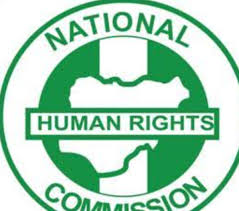
NHRC Calls for Reforms in Correctional Centres, Cites Systemic Bias
By: Michael Mike
The Executive Secretary of the National Human Rights Commission (NHRC), Dr. Tony Ojukwu has called on stakeholders to reflect on the values that Nelson Mandela embodied, including justice, dignity, equality, and compassion, as the world commemorates World Mandela Day.
Dr. Ojukwu made this call in a statement on the eve of the commemoration, noting that Mandela’s legacy serves as a powerful reminder of the need to promote and protect human rights, particularly in Nigeria’s correctional centers.
According to him, the current state of Nigeria’s correctional centres, which are overcrowded, under-resourced, and lack basic sanitation and healthcare, reflects a failure of infrastructure, justice, and humanity.
He lamented that thousands of citizens are held in pre-trial detention for years due to poverty and lack of access to justice, while the rich have greater access to quality legal defense and bail, perpetuating systemic bias.
The NHRC Executive Secretary urged the Nigerian government, judicial authorities, private sector, and civil society to prioritize comprehensive reforms in detention facilities and correctional centers, including improving conditions, investing in alternatives to pre-trial detention, ensuring speedy trials, and upholding the rights of inmates.
Ojukwu emphasized the need to tackle the root causes of incarceration, such as poverty, unemployment, and lack of access to justice, in order to build a society that values the dignity and human rights of all individuals, regardless of their socio-economic status.
Nelson Mandela Day is celebrated annually on the 18th of July.
NHRC Calls for Reforms in Correctional Centres, Cites Systemic Bias
News
Ondo State Government Signs MOU with Backbone Infrastructure for 500,000 BPD Oil Refinery

Ondo State Government Signs MOU with Backbone Infrastructure for 500,000 BPD Oil Refinery
By: Michael Mike
The Ondo State Government has signed a Memorandum of Understanding (MOU) with Backbone Infrastructure Limited for the establishment of a 500,000 barrels per day oil refinery and development of free trade zone in Igbotiri, Ilaje Local Government Area of the state.
The signing ceremony took place at the Governor’s office in Akure.
The Secretary to the State Government, Dr. Taiwo Fasoranti represented the Governor, Dr. Lucky Aiyedatiwa at the ceremony.
He described the proposed investment as timely and strategic, assuring the investors of a peaceful and business-friendly environment.
He emphasized that the project would boost the state’s economy, create meaningful job opportunities, and reduce crime.
In his remarks on behalf of Backbone Infrastructure, the Vice President, Legal & Corporate services, Barrister Wale Adekola expressed appreciation to the Ondo State Government for the opportunity to partner in the infrastructure development of the State and assured of his company’s commitment to ensure successful delivery of the two projects.
Similarly, the Managing Director / Chief Executive of Backbone Infrastructure Nigeria Limited, Engr. Henry Owonka, revealed that the two projects would be accompanied by basic infrastructure such as roads, terminal storage tanks, and other facilities that will change the landscape of the State.
According to the MOU breakdown on the Refinery, Backbone Infrastructure Limited will hold 65% equity, while the Ondo State Government will hold 20% and the Nigerian National Petroleum Corporation Limited (NNPCL) will hold 15% stake.
Meanwhile, the investors have expressed confidence in the leadership and vision of the Aiyedatiwa-led administration, citing the clarity of purpose and support they have received as the reason for choosing Ondo State as their investment destination.
The state government equally pledged its support for the project, which is expected to transform the state’s economy and create jobs.
Present at the signing of the MOU were the Secretary to the State Government, Dr. Taiwo Fasoranti. Attorney General and commissioner for Justice, Kayode Ajulo, SAN , the ONDIPA Team while the Backbone team was led by Dr. Steve Dike, a member of the Board of Directors representing the Chairman, Senator Ken Nnamani, Managing Director/CEO Engr. Henry Owonka, the Vice President, Legal & Corporate Services, other members of the management team from the Backbone infrastructure limited among other top government functionaries.
Ondo State Government Signs MOU with Backbone Infrastructure for 500,000 BPD Oil Refinery
News
Police arrest notorious gunrunners in Benue, recover rocket launcher, AK-47 rifles, thousands of ammunition
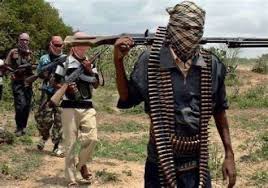
Police arrest notorious gunrunners in Benue, recover rocket launcher, AK-47 rifles, thousands of ammunition
By: Zagazola Makama
Operatives of the Force Intelligence Department–Intelligence Response Team (FID–IRT) have arrested two notorious arms traffickers and recovered a cache of deadly weapons in Abinsi town, Guma Local Government Area of Benue State.
Sources from the Benue State Police Command confirmed the development Thursday, describing the arrest as a major breakthrough in ongoing efforts to curb the proliferation of illegal arms fueling insecurity in the North-Central region.
According to the sources, the suspects led by one Adikwu Ikwulono, a known illegal arms dealer were apprehended on Wednesday following credible intelligence.
Recovered from the suspects were one rocket launcher, five AK-47 rifles, and thousands of rounds of 7.62mm live ammunition.
Police say preliminary investigations revealed that the arms were being assembled for delivery to a gang of armed herders and bandits operating around the Benue–Nasarawa border, with plans to launch coordinated attacks on several communities in Benue State.
“The suspects are currently undergoing intensive interrogation with the FID, while efforts are ongoing to apprehend other members of the arms-smuggling syndicate,” the police sources said.
Police arrest notorious gunrunners in Benue, recover rocket launcher, AK-47 rifles, thousands of ammunition
-

 News1 year ago
News1 year agoRoger Federer’s Shock as DNA Results Reveal Myla and Charlene Are Not His Biological Children
-

 Opinions3 years ago
Opinions3 years agoTHE PLIGHT OF FARIDA
-

 Opinions4 years ago
Opinions4 years agoPOLICE CHARGE ROOMS, A MINTING PRESS
-
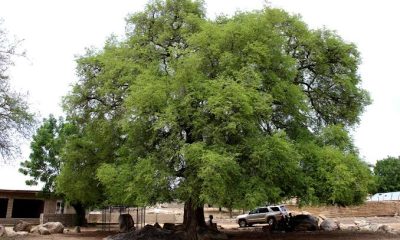
 News1 year ago
News1 year agoEYN: Rev. Billi, Distortion of History, and The Living Tamarind Tree
-

 Columns1 year ago
Columns1 year agoArmy University Biu: There is certain interest, but certainly not from Borno.
-
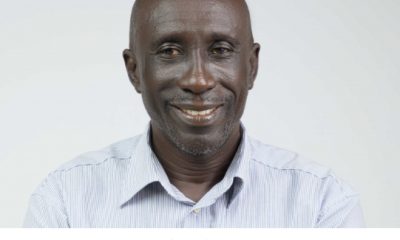
 ACADEMICS1 year ago
ACADEMICS1 year agoA History of Biu” (2015) and The Lingering Bura-Pabir Question (1)
-

 Opinions1 year ago
Opinions1 year agoTinubu,Shettima: The epidemic of economic, insecurity in Nigeria
-

 Politics1 month ago
Politics1 month ago2027: Why Hon. Midala Balami Must Go, as Youths in Hawul and Asikira/Uba Federal Constituency Reject ₦500,000 as Sallah Gift


